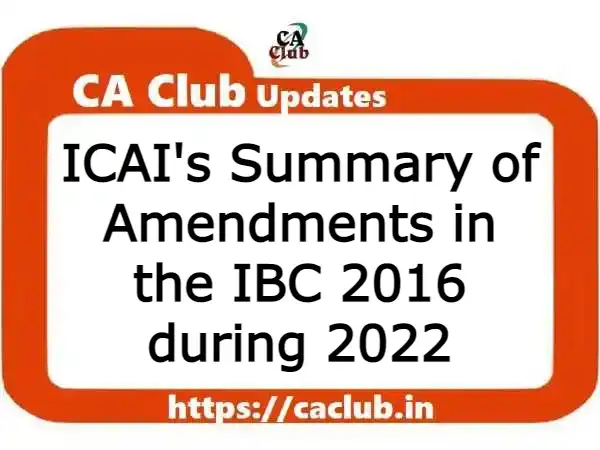The ICAI has published a summary of amendments to Regulations under the Insolvency and Bankruptcy Code (IBC 2016) notified by the IBBI/MCA in 2022 concerning the corporate insolvency resolution process (CIRP), the liquidation process (including voluntary), insolvency professionals, and information utilities.
The IBC 2016 has successfully established a decisive and powerful regime in the arena of insolvency resolution in India. The Code is constantly evolving, and in order for the framework to function effectively and smoothly, the Code as well as the regulations implementing it have been amended on a regular basis.
The overall goal of IBC is to provide a market-determined, time-bound structure for orderly resolution of insolvency where possible and easy exit where necessary. Since its inception, the IBC has been amended six times to improve the efficiency and effectiveness of the processes prescribed. The changes have strengthened and stabilised the processes even more. The regulators are always looking for new ways to improve the IBC’s effectiveness. As a result, the regulations were amended from time to time to address implementation issues.
In the year 2022, several regulatory amendments pertaining to insolvency professionals, information utilities, corporate insolvency resolution process, liquidation process, and voluntary liquidation process were notified with the goal of bringing transparency, maximising value, reducing timelines, and connecting information gaps in the processes. Some of the significant regulatory amendments included:
i) The minimum fee for an Interim Resolution Professional or Resolution Professional ranges from Rs. 1 lakh to Rs. 5 lakh, depending on the number of claims admitted.
ii) A performance-linked incentive fee is provided for resolution professionals in order to achieve timely resolution and maximise value.
iii) In addition to the application under Section 9 of the CIRP, the operational creditor must provide copies of relevant GST return extracts as evidence of default.
iv) The Committee of Creditors formed during the Corporate Insolvency Resolution Process shall serve as the Stakeholders Consultation Committee (SCC) until the Consultation Committee is formed within sixty days of the liquidation commencement date.
v) The Stakeholders Consultation Committee (SCC) may propose to replace the liquidator with a vote of at least 66% and must file an application with the AA for liquidator replacement.
vi) An insolvency professional entity (IPE) who has been enrolled as a member of an insolvency professional agency is now considered a professional member.
Accordingly, the ICAI’s Committee on Insolvency and Bankruptcy Code published a booklet titled “Summary of Amendments in Regulations under the Insolvency and Bankruptcy Code in 2022” as part of its knowledge dissemination and capacity building efforts to help members understand the implications of the amendments made to the various Regulations of the IBC, 2016.
ICAI’s Summary of Amendments in Regulations under The Insolvency and Bankruptcy Code in 2022 (February 2023 Edition)
